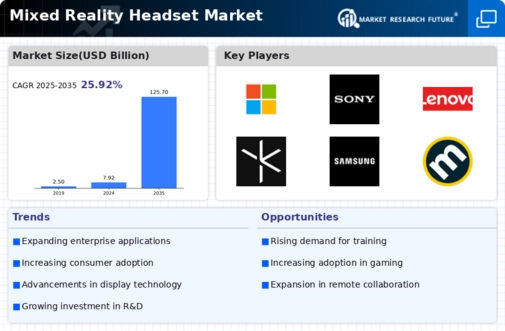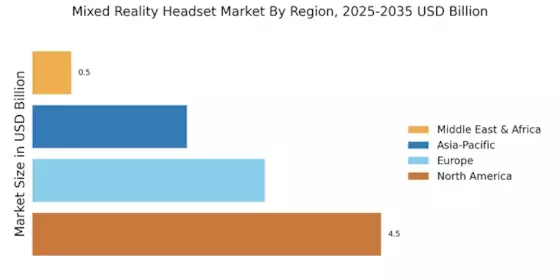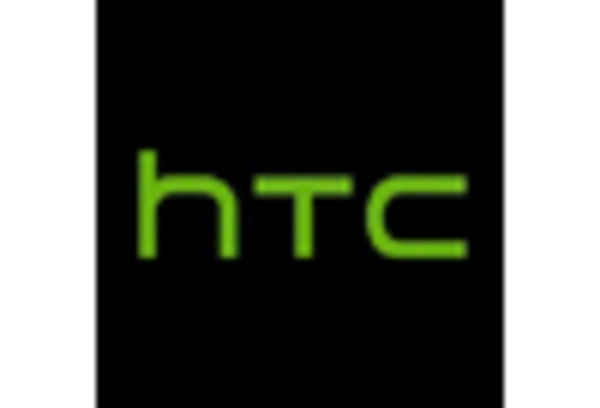Focus on User Experience and Ergonomics
User experience remains a pivotal focus within the Mixed Reality Headset Market, as manufacturers strive to create more comfortable and user-friendly devices. Ergonomics plays a crucial role in headset design, with companies investing in lightweight materials and adjustable features to enhance comfort during prolonged use. Additionally, intuitive user interfaces and seamless integration with existing technologies are becoming increasingly important. Market Research Future suggests that user satisfaction directly correlates with headset adoption rates, indicating that companies prioritizing user experience are likely to gain a competitive edge. As the market evolves, the emphasis on creating immersive yet comfortable experiences is expected to drive growth and foster brand loyalty within the Mixed Reality Headset Market.
Increased Adoption in Various Industries
The Mixed Reality Headset Market is witnessing increased adoption across diverse sectors, including healthcare, education, and manufacturing. In healthcare, mixed reality is being utilized for surgical simulations and patient education, enhancing training and improving outcomes. The education sector is leveraging these headsets for immersive learning experiences, which have been shown to increase retention rates among students. In manufacturing, companies are employing mixed reality for design visualization and remote assistance, streamlining operations and reducing costs. Market data indicates that the industrial segment alone is expected to account for a substantial share of the market, with projections suggesting it could reach over 40% by 2026. This widespread adoption across various industries is likely to drive further innovation and investment in the Mixed Reality Headset Market.
Growing Demand for Remote Collaboration Tools
The Mixed Reality Headset Market is experiencing a surge in demand for remote collaboration tools, particularly as organizations seek innovative solutions to enhance teamwork and productivity. Mixed reality headsets facilitate virtual meetings and collaborative workspaces, allowing teams to interact in real-time, regardless of their physical locations. This trend is particularly relevant in industries such as architecture and design, where stakeholders can visualize projects together in a shared virtual environment. Market data indicates that the demand for remote collaboration solutions is expected to grow significantly, with projections suggesting a potential increase of over 50% in the next few years. This growing need for effective remote collaboration tools is likely to propel the Mixed Reality Headset Market forward, as companies invest in technologies that support flexible work arrangements.
Expansion of Gaming and Entertainment Applications
The Mixed Reality Headset Market is poised for expansion, particularly within the gaming and entertainment sectors. As gaming technology evolves, mixed reality offers unique experiences that blend the physical and digital worlds, captivating audiences and enhancing gameplay. The rise of esports and interactive entertainment is driving demand for immersive gaming experiences, with market analysts predicting that the gaming segment could account for a significant portion of the overall market share. Furthermore, entertainment applications, such as virtual concerts and interactive storytelling, are gaining traction, appealing to a wide range of consumers. Market forecasts suggest that the gaming and entertainment sectors will continue to be key drivers of growth in the Mixed Reality Headset Market, as developers create innovative content that leverages the capabilities of mixed reality technology.
Technological Advancements in Mixed Reality Headset Market
The Mixed Reality Headset Market is currently experiencing rapid technological advancements that are reshaping its landscape. Innovations in display technology, such as higher resolution screens and improved field of view, enhance user immersion and engagement. Additionally, advancements in tracking systems, including inside-out tracking and eye-tracking capabilities, are making mixed reality experiences more intuitive and responsive. According to recent data, the market is projected to grow at a compound annual growth rate of over 30% through the next five years, driven by these technological improvements. Furthermore, the integration of artificial intelligence and machine learning into mixed reality applications is expected to create more personalized and adaptive user experiences, thereby attracting a broader audience and increasing market penetration.


















Leave a Comment